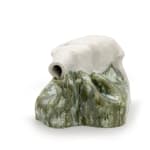Sébastien de Ganay
CERAMIC 107, 2021
Ceramic
20 x 28 x 25 cm
7 7/8 x 11 1/8 x 9 7/8 in
7 7/8 x 11 1/8 x 9 7/8 in
Copyright The Artist
Photo: Simon Veres
Further images
In the CERAMICS work group, de Ganay plays with the juxtaposition and with what at first glance appears to be a paradoxical connection between foreignness and familiarity: “I'm trying to...
In the CERAMICS work group, de Ganay plays with the juxtaposition and with what at first glance appears to be a paradoxical connection between foreignness and familiarity: “I'm trying to create an unexpected presence that is inherently familiar and without any visible traces of production. A presence that arises by chance when a familiar object conveys the feeling of 'déjà-vu' but has no connection to any personal story. A presence that is easily acceptable and self-evident and at the same time convinces with its quiet, enigmatic familiarity." De Ganay classifies his CERAMICS as “familiar objects”, in contrast to the term “specific objects”, which was coined in 1965 by the artist and critic Donald Judd. “Specific objects” are specific because the artist carefully coordinates their shape, scale, proportions and materiality. In comparison, the CERAMICS are both puzzling and familiar, as if they were created by natural chance. The artist uses this ambivalent effect in the CERAMICS as a game to emancipate things from their being and as a possibility to make them look like something other than what they really are. In CERAMIC 107, De Ganay uses ceramic as a sculptural material that absorbs and preserves movement and impressions. The glaze of the sculpture is reminiscent of matt white Carrara marble and, as de Ganay says: "They are nothing less than the expression of potentials and metamorphoses in the making."







